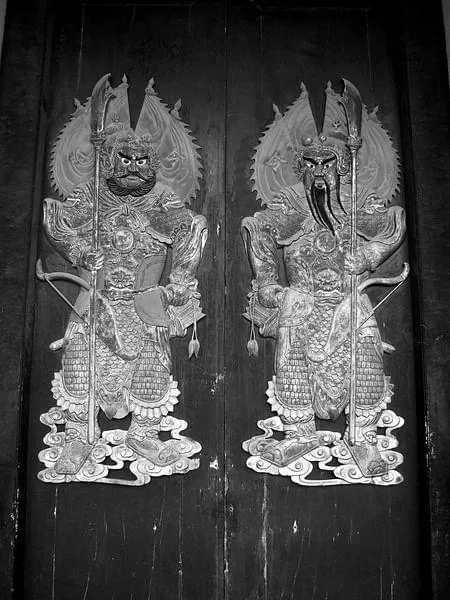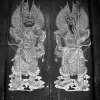Originally from Hangzhou, Wong Tai Sin became famous when he performed miraculous deeds after being taught Taoism by an immortal. His fame spread across China and became a part of the culture, especially in Hong Kong. His image was brought to Hong Kong by a traditional Chinese medicine practitioner during the early nineteenth century.
Shouxing
The deity of life is regarded as one of the most important in Chinese mythology. Although he is not a deity in his own right, he is considered one of the three stars, or Fulushou, and is responsible for controlling life spans. In traditional Chinese mythology, a long life is associated with good fortune and prosperity, so it is no wonder that the deity of life is so revered.
In Chinese folklore, the deity of life is represented as a balding old man, accompanied by a small deer. He is often holding a peach or gourd containing an elixir of life. This is thought to prolong the life span of all humans.
The star associated with the deity of life, Shou Xing, is known as the southern pole star. It is the second brightest star in the night sky. His distinctive features are a high forehead and a peach, a symbol of immortality. His deity is usually smiling, carrying a gourd containing the elixir of life.
In addition to being the deity of life, Shouxing is also associated with prosperity. In Chinese culture, prosperity is associated with happiness, and it is associated with the cultivation of crops. People of the lower class are intimately linked to their crops, because this is what sustains their lives.
Pangu
According to one legend, the Chinese deity of life Pangu grew from an egg to an adult at the age of 18. When he grew up, his breath turned into wind and thunder. His left eye became the sun and his right eye, the moon. Pangu’s head and limbs were transformed into mountains, forests, rivers, and lakes. His veins formed great canyons.
Pangu is believed to have created everything that exists in the world. His blood was gathered by the rivers and streams of the world. His flesh decomposed into fertile soil, while his hair took root and grew into the first trees. As a result, he is the true Creator. Having created the universe and earth, he subsequently created the sun, moon, and stars.
Chinese mythology explains how the world was created. The universe began with the creation of life. Several traditions explain how Pangu arose from a chaotic void. After coming to life, Pangu created the world, which was made up of a combination of yin and yang. In the process, Pangu split the yin-yang into two, the earth and sky. He subsequently held the sky back from the land when they grew to full size.
Many people in China believe Pangu had children. In a folktale, the deity was an expert in rice cultivation, and married a daughter of the Dragon King. They had a son named Xinheng, who had a fiery temper. However, he was very disrespectful of his mother and departed for heaven.
Xiangu
In Chinese mythology, Xiangu is the god of life, the most important element of existence. The deity is sometimes represented with a lotus flower, and is sometimes associated with a musical instrument. Other times, he is associated with a fenghuang or bamboo ladle. Those who consult a xiangu are said to receive advice on their lives, their love life, and their relationships.
According to legend, Xiangu is the eighth Xian. She was born with six long hairs on her crown. When she was about fourteen or fifteen, a divine personage appeared to her in a dream. Upon receiving the divine message, He Xiangu became etherealised and vowed to remain a virgin. She also prayed to the imperial court for protection.
The Chinese are also known to honor the “God of the earth” (Tu Di Gong). The Xiangu is the god of the earth, and he is connected to the earth, minerals, and buried treasure. The Xiangu is also associated with education, as he is the god of students. Students often pray to him in order to succeed in exams. He was also sought by inept examiners for guidance and success.
The Chinese deity of life has eight manifestations. They are portrayed in different poses and clothes. They are all considered immortal, and each has a particular characteristic. For example, He Xiangu is often depicted holding a lotus flower. Other deities are represented with weapons and other items.
Shou Fu Lu Shou
In Chinese mythology, Fu Lu Shou is the deity of long life, prosperity, and health. He is often represented as a figure, often accompanied by a deer. His name, “Shou,” is a combination of the two words, meaning “deer” and “longevity.” The deities are often placed in a row on a wall, one on either side of the work area. Having a Fu Lu Shou in your home or business is believed to bring good luck and unity to your family.
The legend of Lu traces its origins to a poor man named Shi Fen, who worked his way up to high positions. His image is often depicted in the center of the three deities and holds a gold coin, symbolizing the scepter of office. It is believed that this coin will bring you prosperity, a smooth business, and long life.
While Fu Lu Shou are commonly associated with longevity, they have also become the deity of happiness. Their images are commonly found in homes and offices throughout Asia. They have a number of other symbols in Chinese culture and are believed to bring good luck and happiness to your life.
According to Chinese mythology, the star of Shou controls the lifespan of mortals. In addition, the star of Shou represents immortality, which is represented in the peach symbol. The star is also associated with the star of the south pole, which is believed to predict the time of death.
Cheng Huang
Cheng Huang is the Taoist deity of life and immortality. He protects the town from evil and is often a local dignitary. According to legend, he also judges the dead and protects the town’s walls and moats. In addition, he oversees the fortune of the town and exposes evil-doers.
The deity is also associated with the fertility of the earth and the longevity of life. He is one of the Four Guardian Marshal Gods of Taoism. He is also revered by Cantonese opera troupes as the god of performance arts. However, it is unclear how his god-like status came about.
Cheng Huang is an important god in Chinese religion. He protects the earth and the people who dwell on it. He also helps them with their problems and offers help in times of trouble. In the ancient times, he was worshipped by both men and women. In fact, he was the patron deity of fishermen and sailors.
In ancient China, the deity was worshiped by the people as the ruler of the heavens and the earth. He was also known as the Yellow Emperor and Jade Emperor. He was also revered as the supreme god of creation and law. He was the ancestor of all Chinese and gave them their culture, art, and even their ability to fight. In addition to the deity of life, he was also the god of agriculture and the three purities.
Dongyue Da Di
Dongyue Da Di is a Chinese deity. He represents life and death. In the Chinese pantheon, he is one of the highest deities. He reports to the Court of Heaven, which is the highest authority in Chinese beliefs. As such, he is often called the “first master”.







